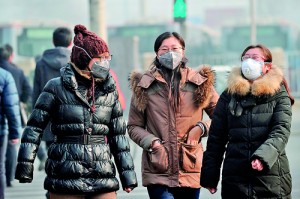Sunday Times 2
China’s new green revolution
Since the reforms of 1978, China has been taking giant strides towards economic development. However, the development work which largely centred on primary products such as iron, steel, cement, and coal, has in its wake created major environmental and health problems.
In 2010 when I travelled from Shanghai to the central part of China by train, I noticed, along the way, high rising funnels belching thick smoke. Even today, thick smog covers some large cities.

A group of women wear face masks as they make their way along a street in Beijing on January 16. China's capital was shrouded in thick smog, cutting visibility down to a few hundred metres as a count of small particulate pollution reached more than 20 times recommended levels. AFP
The main source of power generation in China is coal. Burning of coal for power generation has become a major issue. With this economic progress the life pattern of the Chinese people too changed.
In the good old days China was known as the kingdom of bicycles. Today the story is different with roads in major cities full of motor vehicles. By 2011, there were 82 million motor vehicles on Chinese roads. Annually a 20% increase takes place in motor vehicles. These vehicles emit tons of carbon monoxide to the atmosphere, adding to the growing environmental crisis.
In addition, most of the industries of China are located in the eastern part. People in the western part migrate to the east, seeking jobs and better living conditions. Smoke emitted from the kitchens of millions of houses also contributes immensely to this problem. Added to this is the garbage disposed by millions of houses. The annual average garbage output of a citizen in China is about 440 kg. With its 400 million tons-a-year garbage, China ranks number one in the world in terms of garbage output.
Effluents from factories and plants have also contaminated ground water. Of the 131 rivers that flow through cities in China, 36 are severely contaminated.
The economic progress has affected the agriculture too in a very damaging manner. The heavy use of chemical fertiliser in agriculture is discharged to the ground water and streams contaminating the water used for domestic purposes and horticulture. This in return has affected the food chain. However, the good news is that China has correctly understood the magnitude of this problem and taking corrective measures.
China’s President Xi Jinping says one of his dreams is to create a beautiful China. He firmly believes that a pleasant environment is an absolute necessity for a happy and a contented life. To achieve this goal, the central government and provincial governments spend vast amounts of money.
As an initial step, they have taken steps to relocate iron, cement and coal based industries away from urban areas while attracting hi-tech industries and industries that use little fuel to the cities. Already several computer, electronic and refrigerator, solar panel firms have moved to the urban areas. Of the major 500 companies of the world, 238 have opened factories in Chengdu and most of them are computer based industries. Today this area is known as the silicon valley of China. Two thirds of the world production of tablets is produced in this area. Giants like Motorola, Nokia, Ericson, Microsoft, Samsung, Intel and other digital giants have factories here today. This strategy has contributed to minimising the pollution of air and water in the eastern area.
A drastic change has taken place in the power sector of China during the past five years. China has started to change from coal as its main source of power to alternate sources such as wind power, solar power, sea waves, hydro power, biogas and nuclear energy. China has plans to increase the alternate sources of energy to 15% by 2020, 25% by 2030 and 40% by 2050.
China launched a big project to increase the number of battery operated cars. They spent 500 million Yuan to improve battery charging storage technology. By 2012 China had, electric vehicles and 70% of them were buses. By 2018, Beijing will introduce 8,000 electric buses to its roads.
Green investments
China’s investment in renewable energy during the 12th five-year plan period (2011-2015) will reach 1.8 trillion Yuan. In addition, China plans to save save 3 trillion Yuan in energy savings and emission reduction. By 2015 the Beijing municipal council plans to relocate all coal power plants outside the city limits.
To overcome this problem many provincial governments have taken many steps. One such province is Anhui, whose capital Hefei has seen a green transformation.
Hefei low carbon developments
Modernisation of existing industries, creation of high-tech industries and opening of service providing projects are some of the steps taken by the provincial government.
Hefei is now China’s foremost producer of television sets, washing machines, fridges, air conditioners and similar products or industries which are environment friendly.
There are many electric vehicles on the roads of Hefei. It has planned to produce 10,000 electric cars. It was the first city to run a public transport service entirely served by electric buses. Besides, 80 percent of the city’s street lights use eco-friendly LED bulbs.
Hefei’s new buildings are also a part of the government efforts to create a green city. In 2009 Hefei was chosen out of 26 cities that demonstrated the use of renewable energy in buildings. It won state subsidies to carry out further development.
It is quite evident that the China is taking sufficient preventive measures to minimise the damage caused to the environment by rapid industrialisation. The Chinese government expects to transform the country into an environment-friendly state by 2030. All Chinese people looking forward to an environment with fresh air, clean water, clear skies and uncontaminated green land.
The writer is Vice President of the Sri Lanka China Society

